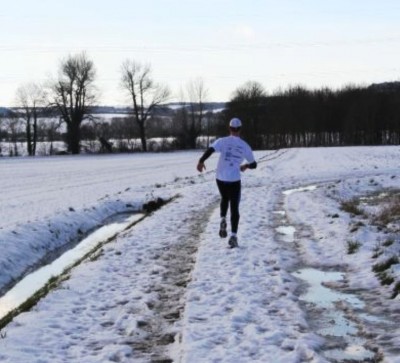
Running in the snow and cold this winter means rethinking your routine.
It’s getting cold out there. As the temperatures drop, it’s hard not to break your usual running regime and opt for warmer workout options. But winter can actually be one of the best times for runners. Less people will crowd your usual running trails, the weather keeps you cooler, and the change of season gives you a whole new reason to go shopping for gear. Follow these few simple tips to take advantage of the season and prepare yourself for the cold.
Dress for the Weather:
Dressing for winter running can be a bit of an art form. You want to wear enough so you are warm, but not so much that you will overheat as your temperature rises while you work out. To prevent over-dressing, give yourself a 10- to 15-degree gap. This means starting with a base layer and adding layers as if you were going out in weather that is 15 degrees warmer. Dressing in fabrics that are insulated but with breathability to prevent sweat condensation is important, so opt for a lightweight, windproof, water-proof jacket. Gloves and a hat are a necessity as well to keep your extremities warm.
Prep Your Feet:
One of the most important things you can do is make sure that you are wearing shoes with great traction and little mesh. Trail shoes are ideal for winter running but, if you can’t get a new set of kicks, many stores sell traction devices like Yak Trax that provide some grip on tough winter trails. Also, if your shoes are too minimalist or full of mesh, your feet are likely to freeze and you may find yourself heading back before you’re ready. Winter runners will also find that standard socks just won’t cut it. Instead, opt for a sock that is warm but allows your feet to breathe, like the Injinji trail sock.
Warm Up:
A lot of people skip this step in order to save time. In the winter, this is the worst thing you can do for your body. If your body isn’t warmed up properly for a run, you are at a greater risk of injury because you needs extra time to become accustomed to the cold. Taking a few minutes to get your heart rate up and loosen your joints will literally warm you up, and make stepping out the door into the cold seem easier.
Run with a Partner:
There are so many reasons to take someone running with you during the winter. First of all, with someone running beside you, you will be more visible to cars, making your run that much safer. Secondly, running with a partner or a group is highly motivating. Not only can they push you to go further and faster, they can also prevent you from wimping out and staying inside because, if you make a plan with someone else, they will hold you accountable.
Safety First:
Running in the winter brings on a whole new set of safety rules. With less light hours, sometimes you will be forced to run at dusk or in the dark. Wearing a safety vest or lightly colored clothing, as well as running with a partner can help make you more visible. The dark can also make the varied road conditions less visible to you, so it is important to be constantly aware. Also, if a path looks treacherous, instead of being a hero, have a Plan B. Safety is also a great reason to run with a partner, so that if you do happen upon a patch of black ice, they can be there to catch you or call for help.
Consider the Weather:
You would be amazed how hard it is to run against the wind. Not only that, but when you are running in the winter after you have sweat, you risk experiencing frostbite. To combat this, make sure you start your run into the wind and finish with it at your back. Sometimes, in the heart of winter, you may be forced to stay inside. Utilizing a treadmill or hitting the gym is not wimping out, it’s playing it safe. If temperatures are below freezing and there is a chance of hypothermia, it’s better to seek other workout options.
Image courtesy Wikimedia Commons user Bill Nicholls
 Your Privacy Choices
Your Privacy Choices
 The
The